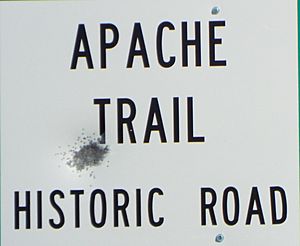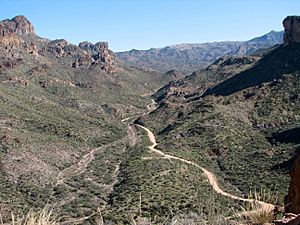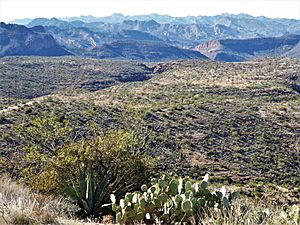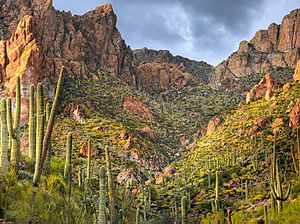Apache Trail facts for kids

The Apache Trail in Arizona is a famous road that used to be a stagecoach trail. It winds through the rugged Superstition Mountains. This trail got its name from the Apache people, who originally used it to travel through these mountains.
This historic trail connects Apache Junction, which is near the big city of Phoenix, with Theodore Roosevelt Lake. It goes right through the Superstition Mountains and the Tonto National Forest.
Most of the Apache Trail is not paved. It turns into a dirt road a few miles past a small town called Tortilla Flat. It stays a dirt road for almost its entire length. The part of the road east of Apache Junction is officially called State Route 88. It's also a main road through Apache Junction. As it goes into Mesa, it becomes Main Street. Then, in Tempe, it's called Apache Boulevard and ends at Mill Avenue.
The trail is about 40 miles (64 km) long and winds steeply through rough desert mountains. You'll see deep lakes like Canyon Lake and Apache Lake along the way. The road is narrow and winding. It's unpaved from just east of Tortilla Flat all the way to Roosevelt Dam. There are steep drops off cliffs and not many safety barriers. Because of this, you need to drive carefully. It's not a good road for large RVs or big vehicles. Some RV rental companies even tell people not to take their vehicles on this route.
In 2019, fires and floods caused a huge landslide between the Fish Creek Hill Overlook and Apache Lake Marina. This part of the road has not been fixed and is closed for now. You can still get to Tortilla Flat from the west side. But to reach Apache Lake, you can only go from the east side.
Contents
History of the Apache Trail
Settlement in the Salt River Valley began after the American Civil War. The United States government wanted to settle lands in the West. Surveys in the Salt River Valley in Arizona showed that the area could be good for farming if water was brought in. The first settlement, Phoenix, grew slowly. But as more irrigation systems were built along the Salt River, new towns like Tempe and Mesa also grew.
However, the Salt River was tricky. Sometimes there wasn't enough water, and other times there were floods. This made it hard for farmers. People realized they needed a steady supply of water. Building a large dam would help. It would store water for dry times and also help prevent floods during wet periods.
The National Reclamation Act
In the late 1890s, the Salt River Valley had its worst drought since the Civil War. People in Arizona and other Western states saw how badly they needed big water projects. This drought also showed that the government needed to get more involved in managing water to make dry lands useful. Because of pressure from newspapers and groups, both major political parties in the 1900 presidential election made water projects a top priority.
So, on June 17, 1902, President Theodore Roosevelt signed the National Reclamation Act into law. This important act allowed the government to plan and pay for large water projects to control and use water in the Western United States.
Building the Theodore Roosevelt Dam
One of the first big projects under the National Reclamation Act was building the Theodore Roosevelt Dam in Arizona. This dam was meant to provide important water and electricity for the growing Phoenix area. The place chosen for the dam was very far away and hard to reach. This made it difficult to bring in building materials and equipment. The solution to this problem was to build the Apache Trail. So, the Apache Trail became a super important road for carrying supplies to the dam site.
Constructing the Apache Trail Road
Work on the Apache Trail, which was then called the Tonto Wagon Road, started on August 29, 1903. The path for this supply road followed an old trail. It's believed that ancient Anasazi tribes used this trail to trade with the Hohokam people. Other Native American tribes might have also used this path long ago to move between their summer and winter homes.
Apache people did most of the hard work to build this road. They lived in separate camps from the other workers. These Apache workers often brought their wives and children with them and kept their traditional way of life. The Apache Trail originally went from the Mesa railhead (where trains stopped) to the dam site. It was finished on September 3, 1905, and cost about $551,000.
The Apache Trail Becomes Famous
After the Apache Trail was finished in 1905, it started to change. While it still brought supplies to the Theodore Roosevelt Dam, it soon opened up for everyone to use. Some business people started offering rides along the road, including both stagecoach and early automobile tours.
These people saw how beautiful and untouched the land around the road was. They started telling everyone about it as a great place to visit. The Southern Pacific Railroad was one of the first companies to use the road's beauty. They had a famous "Sunset Route" train trip from New Orleans to San Francisco. For an extra fee, passengers could take a car side trip over the Apache Trail. It was the Southern Pacific Railway Company that actually came up with the name "Apache Trail" in their ads. They used this name to promote their car tours of the Theodore Roosevelt Dam and the Apache Trail. This name has been used for the road ever since.
|





